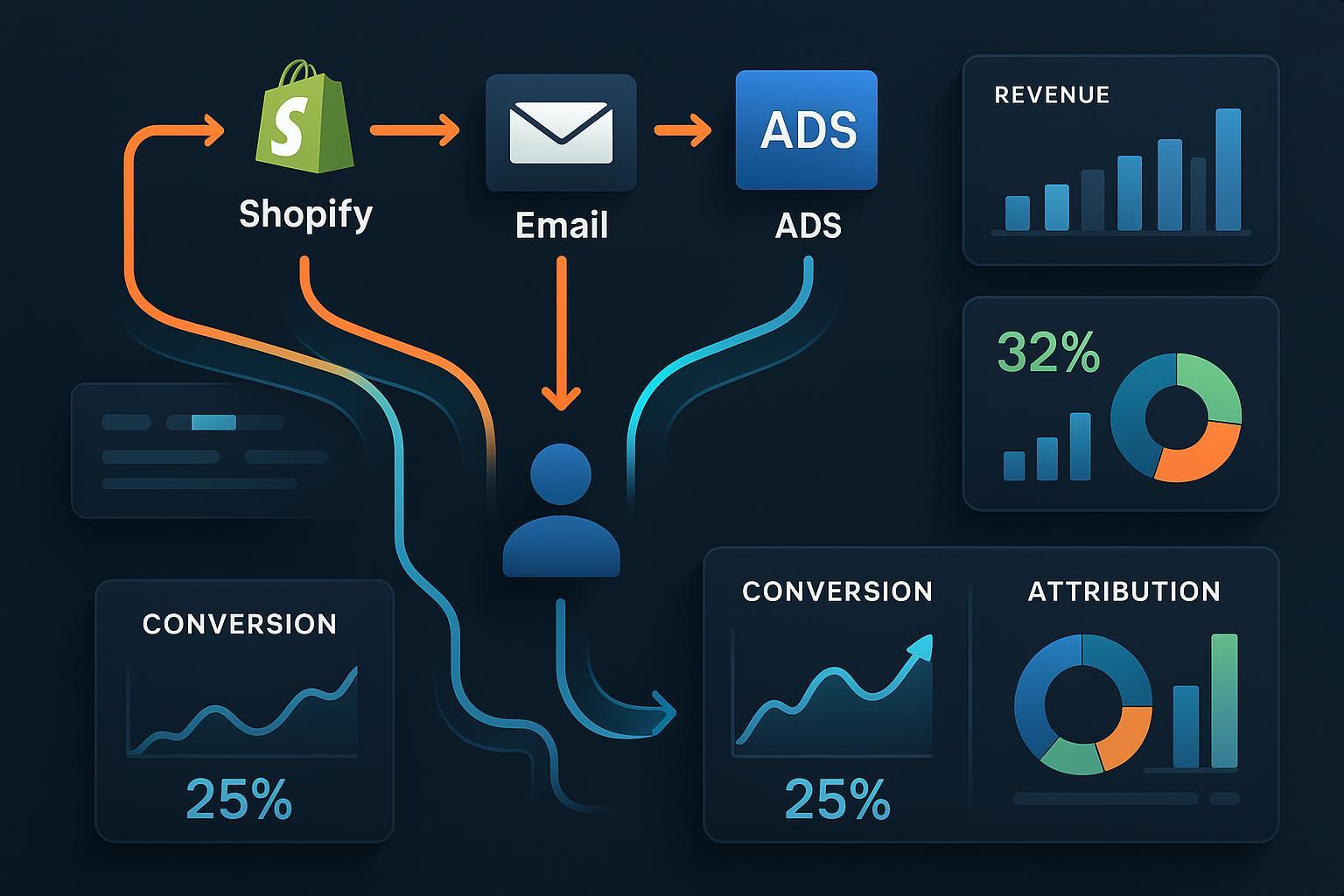Exploring the Connection Between Complex Customer Journeys and Attribution Reporting: Insights for Marketers

Introduction: Why Complexity Has Reshaped Attribution in E-commerce
The modern digital journey for e-commerce buyers is more fragmented and complex than ever—spanning dozens of touchpoints across paid social, organic, influencer, email, SMS, and offline. According to the IAB 2025 State of Data Report, a typical purchase journey can include 15+ interactions and spans 5 or more digital channels. As privacy regulations, third-party cookie loss, and the rise of cross-device behaviors challenge legacy approaches, marketers are under pressure to deliver clear, action-ready attribution. Only by mastering unified journey mapping and advanced attribution reporting can e-commerce brands optimize spend, reduce acquisition costs, and spotlight what truly drives growth.
The Attribution Challenge: Why Legacy Models Fail Modern Brands
Single-touch or last-click attribution models are now widely recognized as outdated for today’s omnichannel world. Forrester reports that brands using basic attribution are 34% less likely to meet ROAS goals in 2024 compared to those leveraging multi-touch and AI-powered models. Core pain points include:
- Data fragmentation: Disconnected channel/platform data makes 360° journey reconstruction impossible.
- Identity opacity: Inability to connect anonymous and known touchpoints leads to wasted retargeting opportunities.
- Model myopia: Last-touch/first-touch models ignore the synergy of multi-step nurturing and cross-device activation.
- Operational drag: Manual data wrangling slows down campaign decision-making—often missing high-value micro-moments.
"Marketers should treat attribution as a dynamic, technical discipline—periodically retooling their stack and calibrating models to reflect evolving customer behavior and regulatory shifts." — IAB 2025
Best Practices for Mapping the Modern Customer Journey
1. Unify All Channel Data Into a 'Single Source of Truth'
Centralizing journey and event data from Shopify, Meta, Google, Klaviyo, and every other touchpoint is foundational. Use server-side integrations or ETL/ELT pipelines to stream real-time interactions into a data warehouse, enabling full journey reconstruction (Saras Analytics, Shopify Reporting Guide).
Pro Tip: Platforms like Attribuly automate unified journey mapping with code-free Shopify, ad, and CRM integrations, resolving identity across known and unknown visitors.
2. Implement Identity Stitching and Cross-Device Tracking
- Deploy server-side tracking combined with persistent IDs (e.g., email, login state, customer number) to link interactions across web, mobile, and offline.
- Utilize AI-driven matching to bridge anonymous session data with authenticated journeys (essential for retargeting and LTV analytics).
- Continuously enrich identity graphs with CRM imports, behavioral segmentation, and triggered emails.
Step-by-Step Example:
- Integrate Shopify, Meta, and TikTok with a platform like Attribuly.
- Enable server-side events and branded link tracking.
- Activate identity stitching—connect anonymous, email-captured, and purchase events into a unified customer profile.
- Review journey visualizations, identifying high-drop-off or high-value segments.
3. Visualize the Full Journey—Not Just the Last Click
Adopt dashboard tools and journey mapping frameworks that display all touchpoints linearly or as a network. Regularly audit for channel interplay, content influence, and friction in the path to conversion.
| Touchpoint | First-Time Visit | Email Signup | Retargeting Click | Purchase |
|---|---|---|---|---|
| Attribution Model | Awareness (20%) | Lead (20%) | Engagement (30%) | Conversion (30%) |
Best Practices for Advanced Attribution Reporting
1. Adopt and Compare Modern Attribution Models
Key Models:
- Linear: Equal credit to all touchpoints.
- Time Decay: Increasing credit as the touchpoint nears conversion.
- U-Shaped: Heavily weights first and last touch.
- W-Shaped: Includes mid-journey influencers.
- AI/Data-driven: Machine learning assigns dynamic credit based on purchase likelihood Usermaven.
| Model | Pros | Cons | Best Use Case |
|---|---|---|---|
| Linear | Easy to explain, fair to all | Ignores touchpoint roles | Simple journeys, small brands |
| Time Decay | Rewards nurturing/retargeting | Can undervalue awareness | Complex, long-cycle e-commerce |
| U-Shaped | Highlights intro + conversion touch | Not dynamic mid-journey | DTC, subscription, omnichannel |
| W-Shaped | Most balanced multi-event value | Slightly complex to set up | Brands with long, multi-influence cycles |
| AI/Algo | Most accurate, adapts to change | Needs quality data, advanced | Scaling brands, mature e-commerce stores |
2. Technical Walkthrough: Setting Up Multi-Touch Attribution
- Server-side Tracking: Ensure all touchpoints are captured regardless of privacy/browser limitations (critical post-iOS 14.5).
- Automated Integrations: Leverage tools/platforms with certified Shopify, Meta, Klaviyo, and Google support to avoid manual data silos.
- Privacy Compliance: Default to first-party and consented data for modeling.
- Model Calibration: Routinely compare model outputs against business goals (ROAS, CAC, LTV) and recalibrate using real purchase/retention data.
3. Enable Real-Time Reporting and Iterative Optimization
Platforms like Attribuly offer live dashboards that unify spend, touchpoint, and conversion insight—empowering marketers to optimize budgets daily, rather than waiting for month-end reports.
Real-World Data and E-commerce Case Example
Case Study: FunnyFuzzy (Shopify/DTC with Attribuly)
- Situation: Fragmented attribution and retargeting limited growth.
- Solution: Attribuly unified all digital journeys, activated AI segmentation, and automated triggered email/Meta campaigns.
- Results:
- 57% more abandoned-email audiences recovered
- 100% increase in Meta audience retargeting efficiency
- Full revenue and ROI visibility across all journeys
| Metric | Before Attribuly | After Attribuly | Uplift |
|---|---|---|---|
| Abandoned Email Recovery | baseline | +57% | +57% |
| Meta Audience Retargeting | baseline | 2x | +100% |
| Unified Revenue Attribution | No | Yes | — |
| Real-time Channel ROAS Visibility | No | Yes | — |
Source: Attribuly FunnyFuzzy Case Study
Industry Benchmark: Brands implementing unified, multi-touch attribution see ~30% improvement in media efficiency and up to 2x ROAS uplift (Forrester/IAB 2025).
Solution Spotlight: How Attribuly Powers Advanced Journey Attribution
Attribuly is purpose-built for e-commerce brands seeking true customer journey visibility and advanced, actionable attribution. It features:
- Code-free, rapid Shopify and major ad platform integration
- Real-time, server-side, privacy-first multi-touch tracking
- Cross-device and unknown/known identity resolution
- AI-powered analytics assistant for segment discovery and predictive optimization
- Automated triggered flows (email, Meta, TikTok)
| Feature | Attribuly | Polar Analytics | Usermaven | NestAds |
|---|---|---|---|---|
| Shopify Integration | ✔️ | ✔️ | ✔️ | ✔️ |
| Code-Free Setup | ✔️ | ✔️ | ✔️ | ✔️ |
| AI Analytics Assistant | ✔️ | ❌ | ✔️ | ❌ |
| Identity Resolution | ✔️ | ✔️ | ✔️ | ❌ |
| Automated Flows | ✔️ | Limited | Limited | Limited |
| Server-side Tracking | ✔️ | Limited | ✔️ | ❌ |
For marketers using Shopify or operating DTC brands, Attribuly eliminates blind spots and accelerates iterative growth without developer bottlenecks.
Actionable Recommendations & Resources
- Checklist: Unified Attribution Best Practices
- [ ] Centralize all platform and CRM data sources
- [ ] Enable server-side, privacy-compliant tracking
- [ ] Implement cross-device, cross-session ID resolution
- [ ] Test and calibrate attribution models against business KPIs
- [ ] Leverage real-time analytics dashboards
- Key Resources & Further Reading:
Conclusion: Take Ownership of the Full Customer Journey
Marketers can no longer afford to operate blindfolded—today, the data and technology exist to reconstruct the full customer journey and assign ROI with scientific precision. Implementing best-in-class practices isn’t just a technical exercise, but a competitive imperative for e-commerce and DTC leaders.
Ready to unify your data and unlock touchpoint-to-revenue truth? Try Attribuly for free and see how advanced journey attribution can power your next leap in growth.
